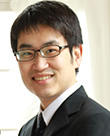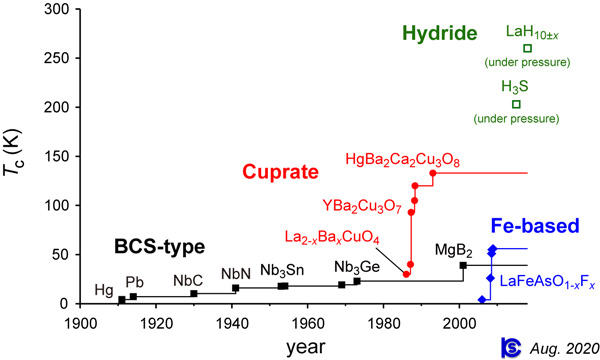2020.11.06
Hot Topic in the research field of superconductivity

- Shunichiro Kittaka
- Associate Professor, Faculty of Science and Engineering, Chuo University
Area of Specialization: Condensed matter physics
1. Introduction
Normally, current flowing in a metal is scattered by atoms (lattices) and impurities in crystals and is attenuated rapidly. However, current flows permanently in some metals when they are cooled to cryogenic temperatures near absolute zero (−273.15ºC). This special state, where electric resistance is zero, is called "superconductivity." Superconductivity is expected to be applied to new technologies that will bring about drastic changes in our society, such as power transmission lines with zero energy loss and large-scale electricity storage, and has already been put to practical use in some fields, such MRI. Recently, superconductors are receiving attention as quantum computer devices as well. In most cases, however, the temperature where a superconducting state is achieved (the superconducting transition temperature) is lower than the boiling point of liquid nitrogen (−196ºC), which is inexpensive, and therefore, achieving a superconducting state requires a cryogenic environment, which is expensive and is hard to handle. This is a high hurdle to overcome in the application of superconductivity. To overcome it, research is underway all over the world with the aim of developing substances with a high superconducting transition temperature and figuring out the mechanism of superconductivity.
2. Conventional Mechanism of Superconductivity
The standard theory of superconductivity (BCS theory) was published in 1957, and it is known that a superconducting state is achieved when multiple electrons moving randomly pair up and move coherently in waves. The "attractive force" that pairs up electrons is an important key in understanding the mechanism of superconductivity. The BCS theory suggests that a superconducting state is caused by lattice vibration and interaction between conducting electrons and perfectly explained the characteristics of many of the superconductors that had been discovered at that time. However, there was a pessimistic prediction that, because the superconducting transition temperature depends on the lattice frequency, common metals would have a superconducting transition temperature below 40 K (−233ºC) or so. In reality, the superconductors that had been discovered before 1980 had transition temperatures no higher than 23 K (−250ºC), which had been called the "BCS wall."
3. Pathway to High-temperature Superconductivity
According to the BCS theory, using a substance with a high lattice frequency is an effective means to achieve a high transition temperature. Theoretically, it was believed that high-temperature superconductivity could be achieved by using the high lattice frequency of atoms of hydrogen, the lightest element. Recently, thanks to the development of experimental techniques under ultra-high pressure, it has become possible to metalize substances rich in hydrogen, and in 2015, a German research group discovered hydrogen sulfide superconductivity, whose transition temperature is 203 K (−70ºC) under 1,500,000 atmospheres, which broke the previous record by a wide margin. In 2019, high-temperature superconductivity with a transition temperature above 250 K (−23ºC) was discovered in hydrogenated lanthanum[1], raising expectations for room-temperature superconductivity. Unfortunately, these hydrogen compounds decompose when the pressure is lowered, so it is difficult to apply them as superconducting materials.

Figure: Trends in superconducting transition temperature[2] (273.15 K = 0ºC)
4. New Types of Superconductivity
According to the BCS theory, it had been expected that, with common metals not containing hydrogen, it was difficult to achieve superconductivity with a transition temperature above 40 K because there is an upper limit to lattice frequency. However, superconductivity was discovered in CeCu2Si2, which had been believed not to become superconductive because a Coulomb repulsive force acts between electrons within the time scale of the lattice vibration. After that, it was revealed that there exist many superconductors beyond the standard framework suggested by the BCS theory. A typical example is the high-temperature cuprate superconductor, which was discovered in 1986. This superconductor still has the highest superconducting transition temperature at normal pressure (−140ºC), and aroused enthusiasm for high-temperature superconductivity when discovered. In addition, the iron-based superconductivity discovered in 2008 is a new type of superconductivity. These types of superconductors are considered to generate an effective attractive force between electrons with orbital or spin fluctuations, and research into them is still ongoing. These new types of superconductivity do not use lattice vibration as conventional types of superconductivity do, so are not subject to the "BCS wall." Therefore, they are attracting attention as a key to achieving high-temperature superconductivity.
5. Figuring out the New Mechanism of Superconductivity with Rotating Magnetic Field Experiments
Many new types of superconductivity have been discovered in strongly-correlated electron systems, in which many electrons interact strongly with each other. It has been learned that, in these systems, the Coulomb repulsion between the electrons can be avoided by an unconventional pairing, in which the pairing amplitude vanishes when both electrons are on the same site. Many of such unconventional superconductors have an anisotropic superconducting energy gap, and the superconducting gap structure is a key to identifying the pairing mechanism. However, many of these new types of superconductivity have a low transition temperature of 3 K (−270ºC) or less, and difficult experiments were required to study the gap anisotropy.
We have been focusing on developing experimental techniques to identify the anisotropy in the superconducting gap based on how the amount of superconducting electrons changes under a rotating magnetic field. More specifically, we developed a calorimeter that can measure specific heat, which can be used to evaluate the amount of broken electron pairs, at temperatures as low as nearly absolute zero, or 0.04 K (−273.11ºC), and combined it with a vector magnet system that can control the direction of the magnetic field in 3D space to study the gap anisotropy with various superconductors[3][4]. As a recent result of this research, we presented experimental data showing that superconductor UTe2, which is extraordinarily resistant to magnetic fields, has gap-zero points in the a-axis direction, thereby suggesting that this superconductor has an unusual internal degree of freedom[5]. Some of the research using this system brought about discoveries that revised long-held ideas. For example, it was experimentally demonstrated that CeCu2Si2, the new type of superconductor discovered first, has isotropic superconducting gaps despite it being a strongly-correlated electron system[6]. This suggests the surprising possibility that electrons on the same site can be paired even when they are subject to a strong Coulomb repulsive force. As just described, cryogenic experiments have contributed to revealing new aspects of superconductivity, offering hot topics in the field of condensed matter physics.
6. For Future Helium Crisis
Cryogenic experiments offer us valuable information in condensed matter physics research as well as superconductivity research. For cryogenic experiments, a large amount of cryogen is required, and helium, which can exist as a liquid even at −269ºC, is commonly used. Helium is a light element, so goes into space once released into the atmosphere. Therefore, helium is considered to be a scarce resource, as there is a concern of it being depleted. In recent years, Japan, which relies on exports from other countries, has often encountered a helium supply crisis, and in serious cases, researches using liquid helium have been suspended. In 2019, several groups, including the Physical Society of Japan, issued an emergency statement[7]. We will also be making efforts to develop an experimental environment in Chuo University that can address a future helium crisis while introducing a liquid helium re-condensation system and cryogen-free refrigerator.
7. Conclusion
In cryogenic environments, we encounter mysterious phenomena we rarely see in our daily life. As a typical example, this paper has introduced superconducting phenomena. Many other mysterious phenomena remain unrevealed. The superconductivity discovered in mercury about 110 years ago is a phenomenon that occurred at a cryogenic temperature of −269ºC. Today, such a phenomenon can be seen at nearly room temperature, though under extremely high pressure. The progress of superconductivity research has also deepened our understanding about the diversity of superconductivity. Practicable room-temperature superconductivity may be discovered in the near future. Although it is difficult to bring the results of such steady fundamental research back to society, it is an important first step to making a drastic change in future society. We will keep exploring novel phenomena under ultimate environments that may defy common sense.
References
[1] A. P. Drozdov et al., Nature 525, 73 (2015).
[2] Homepage of Kittaka group https://www.phys.chuo-u.ac.jp/labs/kittaka/index.html
[3] T. Sakakibara, S. Kittaka, and K. Machida, Rep. Prog. Phys. 79, 094002 (2016).
[4] S. Kittaka, T. Sakakibara, K. Machida, Kotai Butsuri (Solid State Physics), 51, 411 (2016)
[5] S. Kittaka et al., Phys. Rev. Research 2, 032014(R) (2020).
[6] S. Kittaka et al., Phys. Rev. Lett. 112, 067002 (2014).
[7] Seimei "Heriumu Risaikuru Shakai wo Mezasite" (Statement, "Toward a Helium Recycling Society") https://www.jps.or.jp/information/2019/12/helium.php
Shunichiro Kittaka
Associate Professor, Faculty of Science and Engineering, Chuo University
Area of Specialization: Condensed matter physics
Shunichiro Kittaka was born in Ibara City, Okayama Prefecture in 1982. He graduated from the Faculty of Science, Kyoto University in 2005. He earned his Master’s degree from the Graduate School of Science, Kyoto University in 2007. He then earned his Doctoral (Ph.D.) degree from the Graduate School of Science, Kyoto University in 2010. He was a Doctor of Science at Kyoto University. He worked as an assistant professor for the Institute for Solid State Physics, The University of Tokyo, and took his current post in 2020.
In 2020, he was granted the Young Scientist Award in the category of science and technology by the Minister of Education, Culture, Sports, Science and Technology. He is conducting research on superconductivity and magnetism, focusing on developing unique experimental apparatus and precisely measuring physical properties under ultimate environments.
